Overview
In this report, we will explore the Q3 2024 landscape of Web3 hiring based on the listings of over 200 tech job roles from Calyptus' 60+ hiring partners.
We'll delve into the top-paying positions, skills required and salaries shaping Web3. As well as segmenting the industry by geography, seniority and work preferences to gauge valuable insights for employers, hiring managers and tech professionals alike.
Breakdown: Salaries & Skills Required. Salary Averages by Category
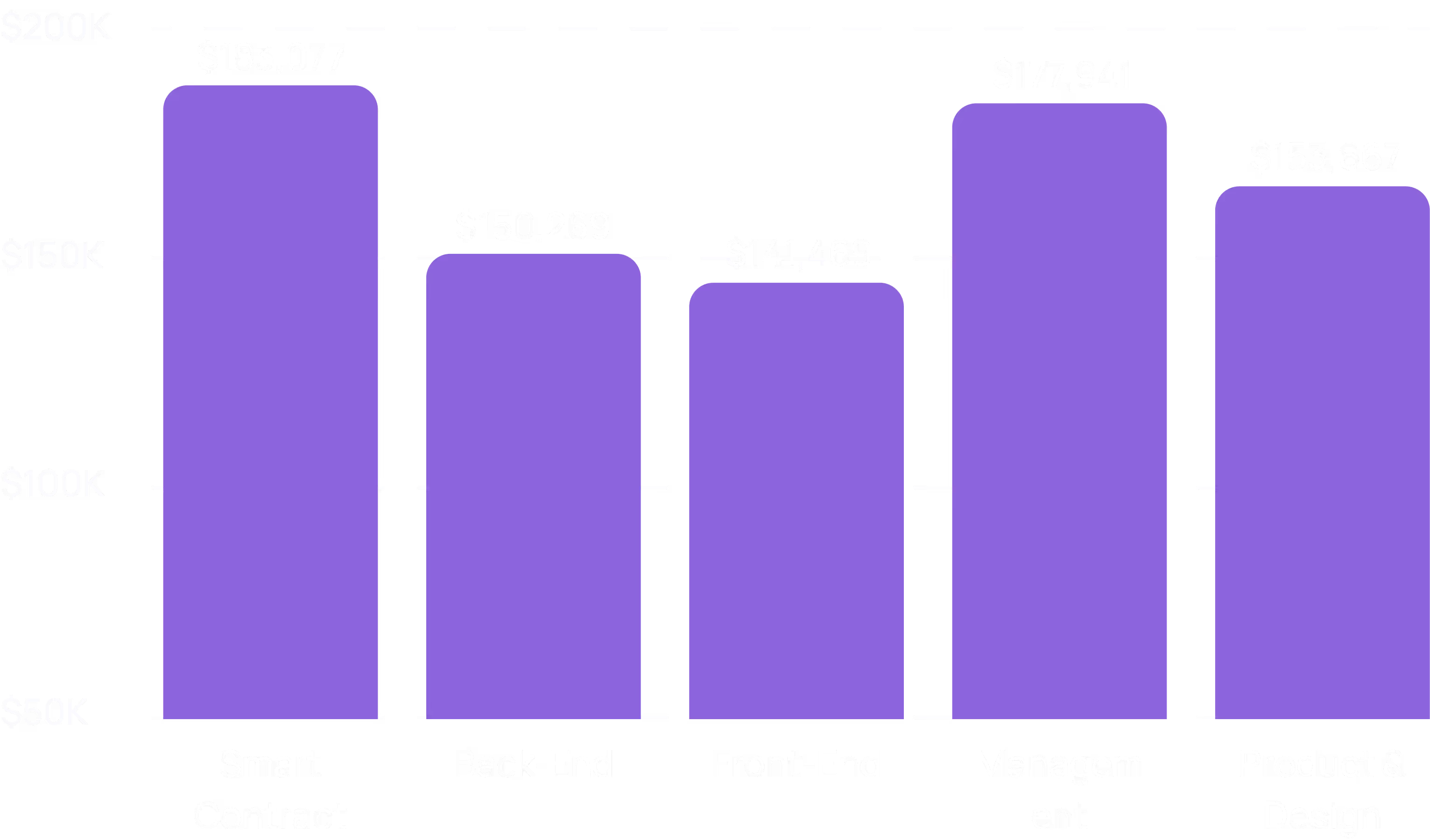
The Web3 job market continued to offer competitive salaries across different roles, with Backend, Management, and Smart Contract Developer roles showing the highest upper salary ranges. Demand for skilled professionals in Web3 remained robust, with companies prioritizing technical expertise in blockchain technologies (e.g, Solidity, Rust) and cross-functional skills in design and leadership.
Solidity, Rust, blockchain development, and security. The emphasis on Solidity and Rust highlighted the need for expertise in blockchain-specific languages, while security-focused skills indicated the high stakes associated with this role in safeguarding decentralized applications.
An average salary of $183,077. The salary range spanned from $62.5K to $300K, with the majority falling between $166.25K and $203.75K.
TypeScript, Python, Golang, Rust & Solidity. This skill set highlighted the importance of versatile backend expertise, with a particular emphasis on blockchain-oriented languages such as Solidity and Rust, along with traditional languages like Python and TypeScript.
An average salary of $150,269, with compensation ranging from $55K to $310K. The majority of Backend Developers earned between $105K and $185K.
React, TypeScript, experience with frontend development, familiarity with native apps. Companies valued developers who could create responsive and intuitive interfaces, with a focus on frameworks that support seamless Web3 integration.
An average salary of $141,469. Salaries for this role spanned from $55K to $250K, with the middle range between $111.25K and $167.5K.
Software eng background, software architecture, and leadership experience. Companies valued leaders who could actively engage with the technical aspects of Web3 projects while also overseeing high-level strategic initiatives.
Management roles were among the highest-paid, with an average salary of $177,941, ranging from $95K to $325K.
Product design, portfolio management, UX, and technical design skills.
An average salary of $153,658, with a range from $72K to $300K. The data showed that designers and product managers with Web3 expertise were increasingly in demand.
Highest Salaries Across Web3 Roles
Lowest Salaries Across Web3 Roles
The highest-paid roles in each category generally required senior-level experience combined with deep technical knowledge in Web3 or blockchain-specific technologies, such as Rust and Solidity. These roles emphasized both specialization and experience in the Web3 domain. Conversely, the lowest-paid roles, while still requiring solid experience, often had more general skill requirements, were mid-level or in-office, and focused on foundational technologies. They also tended to be in locations with traditionally lower salary bands.
This trend underscored the premium placed on advanced Web3 skills and the flexibility to work remotely, which significantly influenced compensation levels. For job seekers, this data offers a clear pathway: cultivating niche Web3 skills, such as MOVE language, rollup frameworks, or a blend of frontend expertise and Web3 knowledge, led to higher earning potential. For employers, it illustrated the importance of aligning compensation with both skill specialization and flexibility in work location.
Workplace Preference in Web3
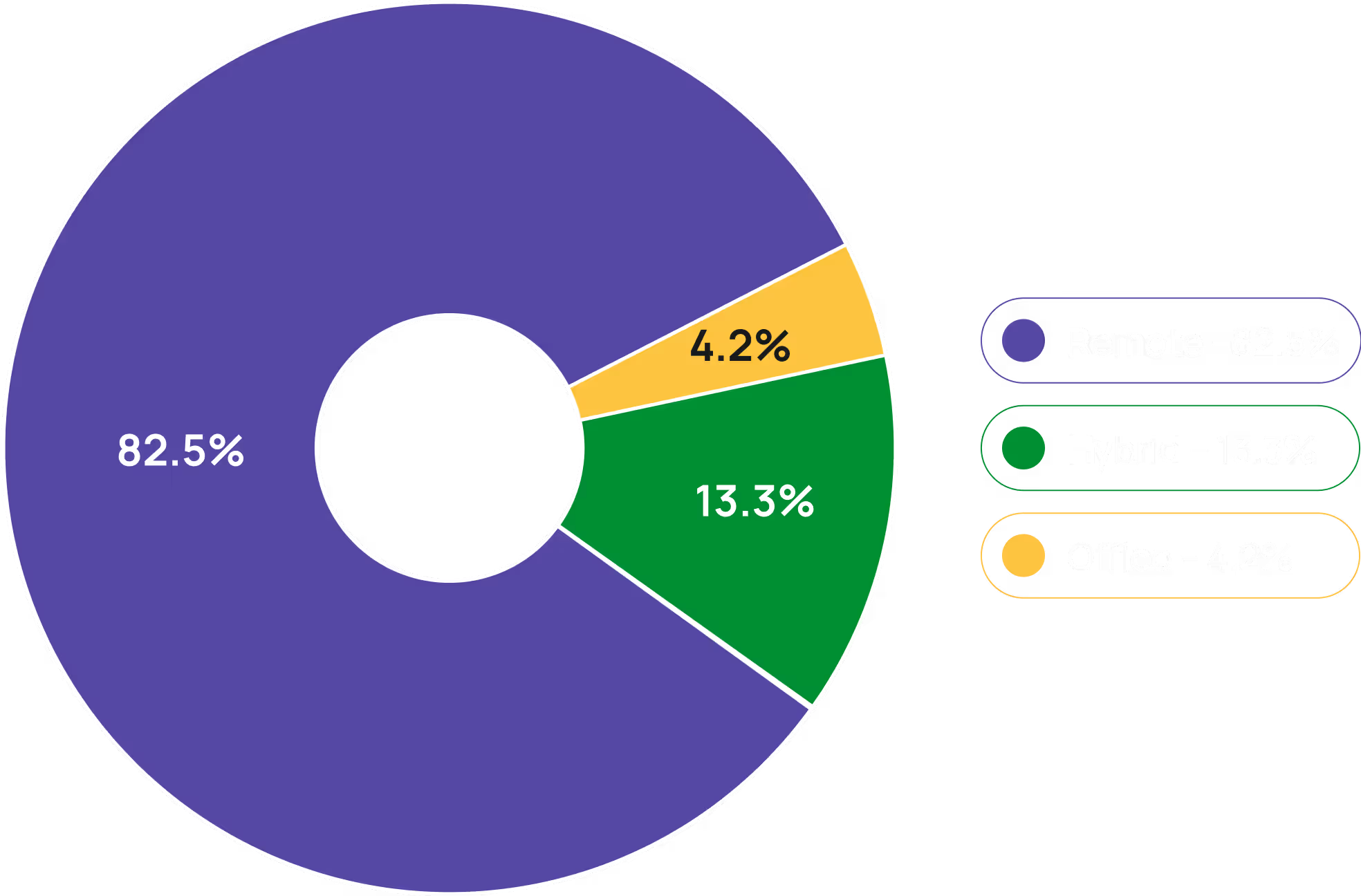
This significant proportion emphasized the Web3 sector's commitment to remote work, enabling companies to attract a global talent pool and offering professionals greater flexibility.
Hybrid roles reflected a blend of on-site collaboration and remote flexibility, allowing companies to foster team cohesion while maintaining some degree of in-person interaction.
These roles, being the smallest proportion, indicats that traditional office-based positions are less common in Web3, which is known for embracing distributed team structures.
The dominance of remote roles illustrated the Web3 sector’s alignment with modern, flexible work trends. This setup not only broadened the available talent pool but also supported the sector’s rapid expansion by reducing geographic limitations on hiring. Hybrid roles, although fewer, provided an option for those who benefitted from occasional in-person interactions while enjoying the flexibility of remote work. Meanwhile, the minimal presence of fully in-office roles underscored the industry's innovative and forward-thinking nature, which often prioritizes output and collaboration over physical presence.
Seniority Breakdown in the Web3 Sector
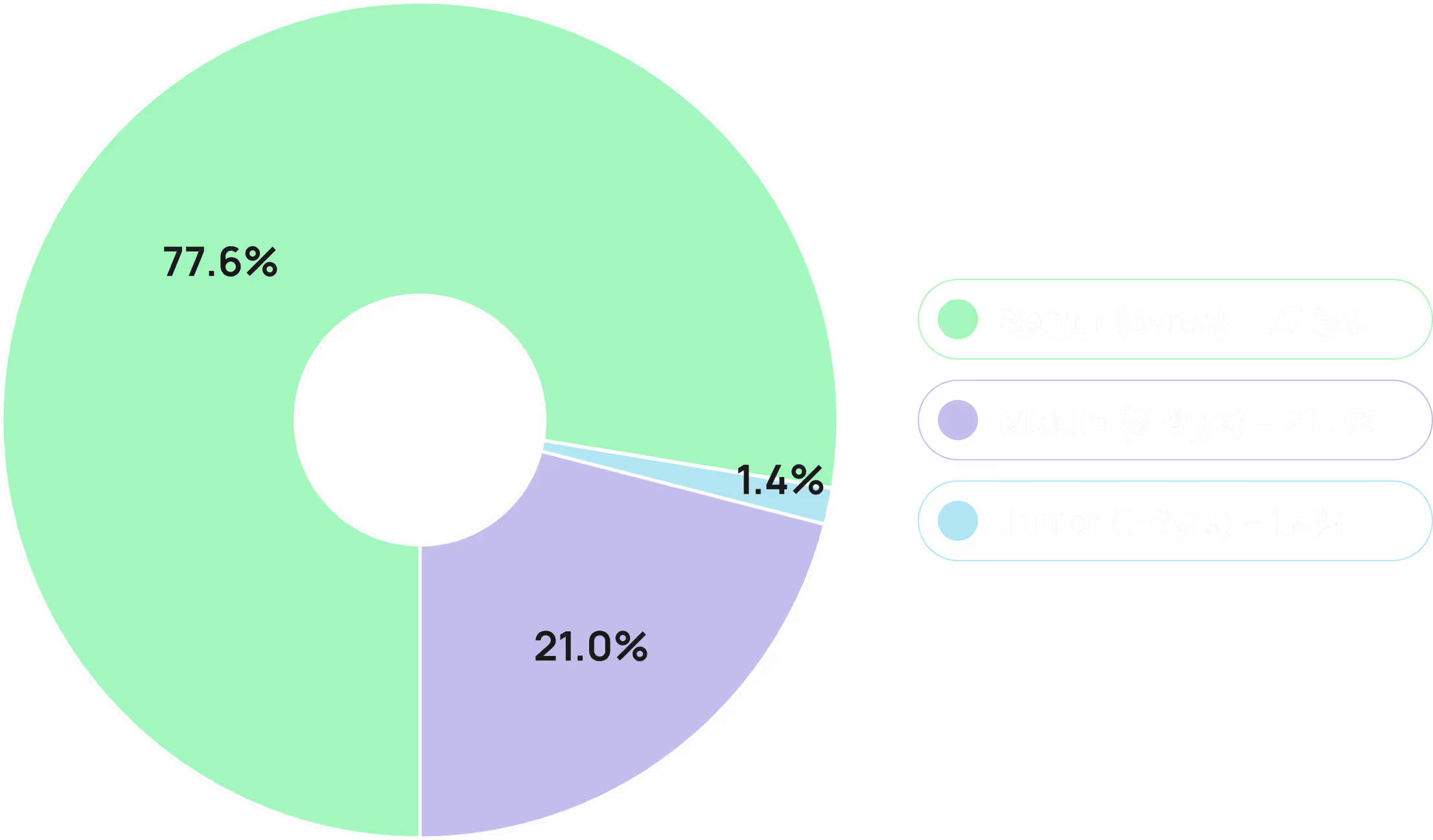
The Web3 industry demonstrated a strong reliance on experienced professionals, with 77.6% of roles designated as senior positions. The high percentage of senior roles reflected the industry's need for individuals who could navigate the rapidly evolving landscape of Web3, where the integration of advanced technologies required a deep understanding of both technical and strategic elements. For job seekers, this indicated a favourable environment for senior-level professionals looking to leverage their experience in high-impact roles.
Mid-level professionals were essential in bridging the gap between high-level directives and practical implementation. This distribution suggested a balanced approach within teams, where mid-level employees contributed stability, continuity, and the potential for leadership development. For employers, mid-level roles provided an opportunity to cultivate future leaders by fostering an environment that encouraged growth and skill development.
Junior roles, making up only 1.4% of positions, reflected a limited yet strategic entry point for new talent within the Web3 space. Although this was a small proportion, it indicated that the sector was starting to invest in nurturing emerging talent, albeit selectively. This distribution suggested that most junior hires were expected to demonstrate foundational skills in Web3 technologies from the outset, given the high standards and rapid pace of the industry.
The dominance of senior roles in the Web3 sector highlights the industry's current stage of development, where expertise, ability to work autonomously and leadership were paramount to driving forward innovative projects. While the presence of mid-level roles showed a commitment to sustainable growth and workforce development, the limited number of junior roles indicated that Web3 companies prioritized experienced hires. Nonetheless, by gradually opening more entry-level positions, the industry could further diversify its talent pipeline and invest in the future of Web3. Organizations that strategically expanded opportunities across all seniority levels would likely benefit from a dynamic and adaptable workforce, ensuring long-term success and industry leadership.
Web3 Salaries by Region

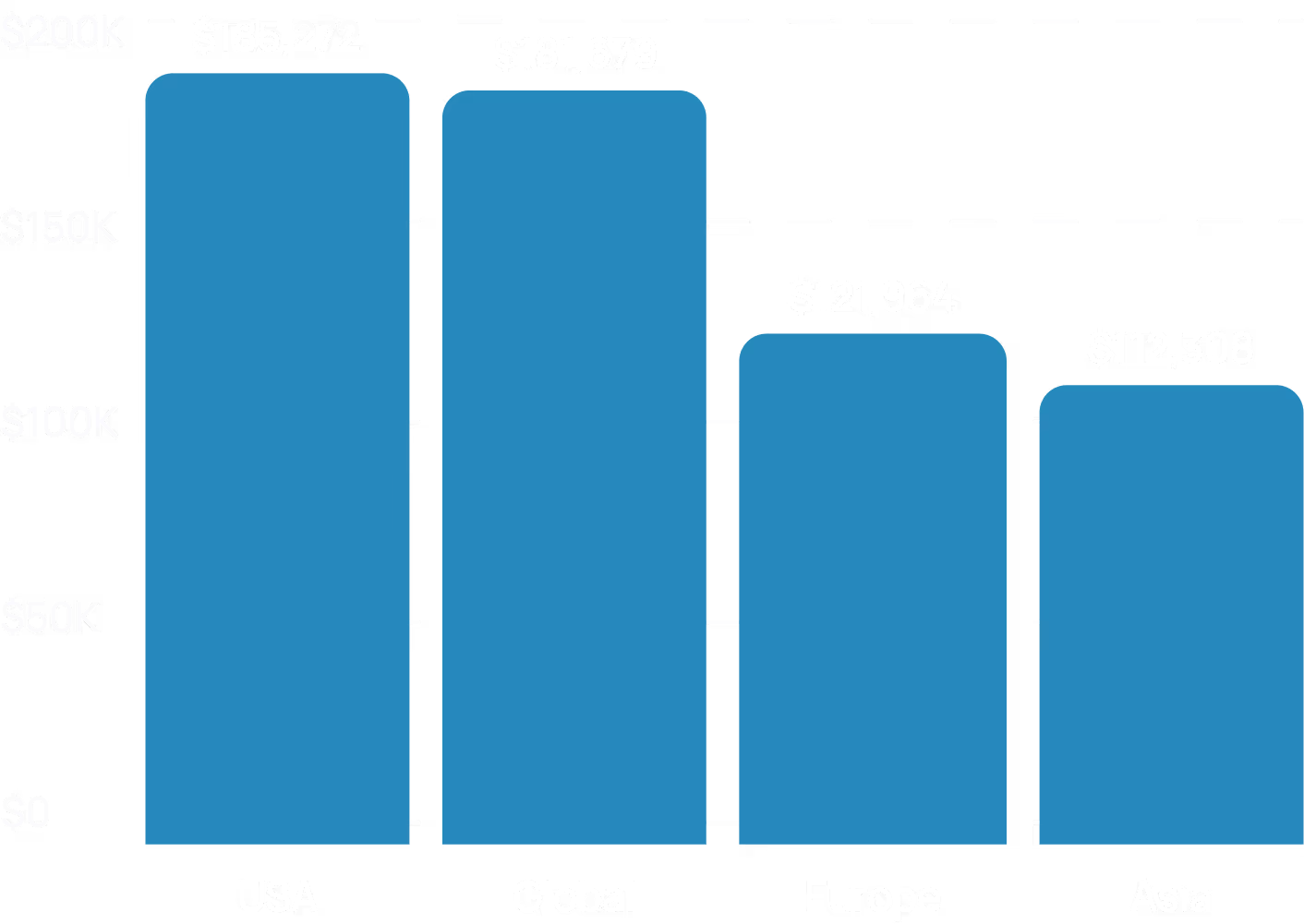
Average Salary: $185,272, with a range from $100K to $300K.
This upper range indicated a competitive salary landscape, especially for senior positions, which were likely aligned with the region’s high cost of living and demand for Web3 talent. The U.S. continued to attract top talent through competitive compensation, particularly for roles that required advanced technical skills and leadership.
The highest proportion of roles was accessible to candidates in the United States, accounting for 32.2% of all positions. This reflected a strong demand for talent in the U.S., likely driven by the robust tech ecosystem, established blockchain communities, and access to venture capital. U.S.-based candidates benefited from a high concentration of roles within Web3, providing diverse opportunities and reinforcing the country’s status as a major hub for blockchain and decentralized technology. For companies, this focus suggested a need for U.S.-specific regulatory knowledge and infrastructure familiarity.
Average Salary: $181,679, with salaries ranging from $85K to $310K.
This broad range suggested that companies were willing to pay premiums to attract talent from around the world. The middle 50% of global roles earned between $150K and $225K, highlighting a significant earning potential for remote, globally accessible positions. The similarity in average salaries between Global and U.S.-specific roles reinforced the decentralized nature of the Web3 industry, where location was less relevant, and skills were highly valued.
Roles that were globally accessible also made up 29.4% of the workforce, highlighting the Web3 sector’s inclination towards inclusivity and borderless hiring practices. These positions catered to a truly global talent pool, allowing companies to attract the most qualified professionals, regardless of their location. Global roles underscored the Web3 industry’s decentralized ethos, where talent from anywhere in the world could contribute to and drive forward the development of blockchain projects. For job seekers, globally accessible roles represented a chance to engage in cutting-edge work from virtually any location.
Average Salary: $121,964, spanning $55K to $325K.
While the upper end of the salary range was competitive, the median salary ($116.25K) and interquartile range were lower compared to U.S. and Global roles. This distribution reflected a more diverse salary structure in Europe, where economic conditions and cost of living vary widely across countries. Companies hiring in Europe could access a wide pool of skilled professionals, often at a cost advantage relative to the U.S.
Europe followed closely, with 29.4% of positions available to candidates within the region. This data underscored Europe’s growing role in the Web3 space, supported by a maturing regulatory landscape and increasing interest in digital finance and blockchain technology across the continent. Companies looking to hire European talent could benefit from the region’s varied perspectives and language proficiencies, which contributed to more diverse project outcomes and stronger cross-cultural insights.
Average Salary: $112,308, with a range from $60K to $200K.
The interquartile range of $95K to $125K suggested that most salaries were concentrated at the lower end of the spectrum. This distribution may reflect lower living costs in some Asian countries, as well as a different competitive landscape. However, the presence of roles paying up to $200K indicated strong earning potential for specific, high-demand skills in certain areas.
The smallest proportion of roles was open to candidates exclusively in Asia, at 9.1%. This relatively low percentage may have been due to regulatory challenges in some parts of the region, or it could reflect a focus on other markets for Web3 expansion. However, Asia remained a critical market for blockchain technology, with rapidly growing interest in countries such as Singapore, Japan, and South Korea. For companies, increasing roles accessible to Asian talent could enhance their reach in these high-growth markets, offering valuable local insights and expanding their influence across diverse blockchain communities.
The geographic breakdown of salaries in the Web3 sector highlighted a strong preference for offering competitive compensation to U.S. and globally accessible roles. This trend aligned with the high demand for advanced Web3 expertise in these markets. European roles, while offering slightly lower median salaries, provided diverse opportunities across a broad salary range, likely due to varying economic conditions within the continent. Meanwhile, Asian roles showed a more conservative salary structure, reflecting both regional economic factors and the relative scarcity of highly paid positions. For job seekers, this data underscored the importance of considering location flexibility when aiming for top-tier compensation in the Web3 space. Organizations should continue to adapt their salary offerings to attract and retain talent globally, recognizing the decentralized and borderless nature of the industry.
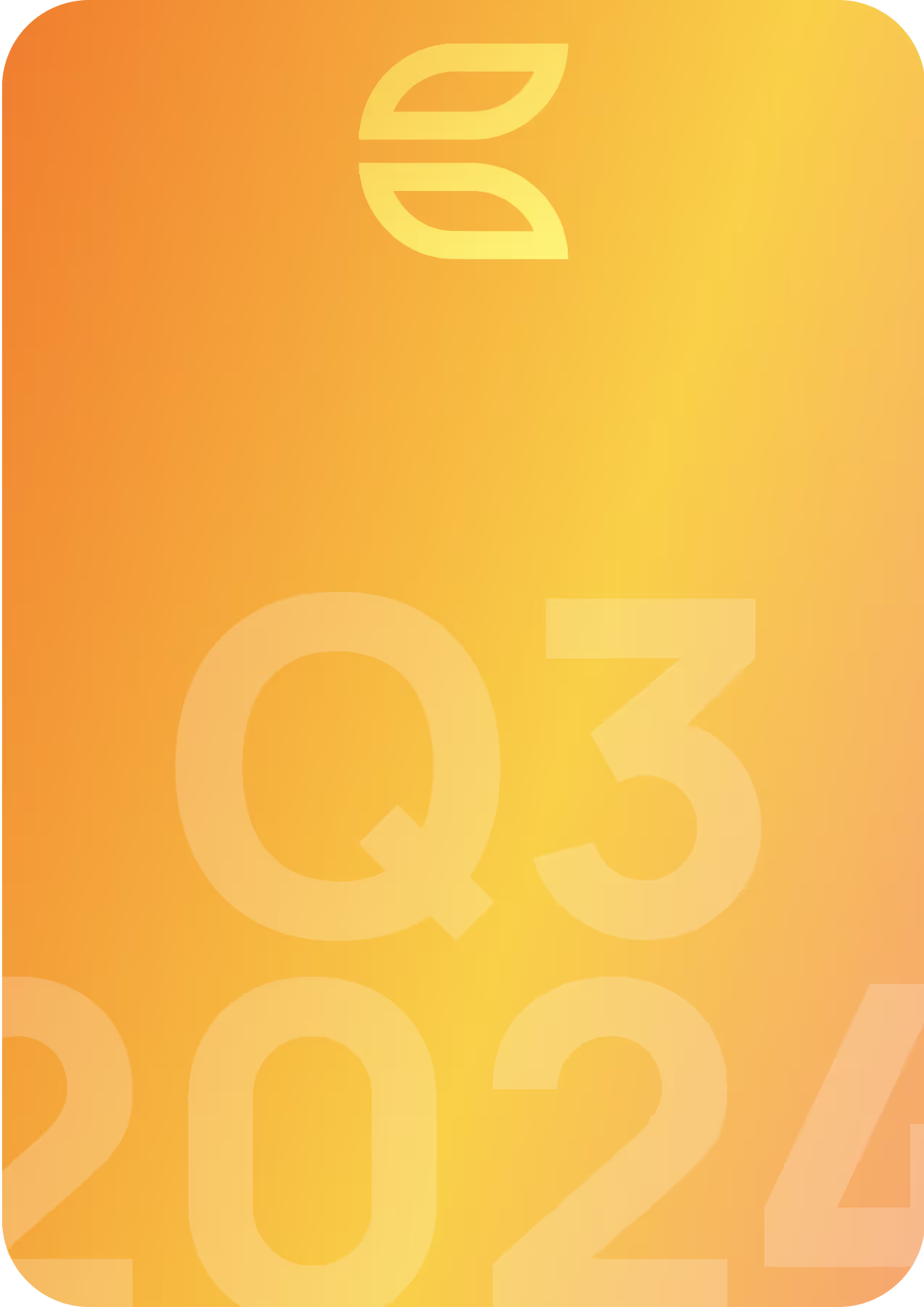
Summary
The Web3 job market offered competitive salaries, especially for Backend Developers, Smart Contract Developers, and Management roles. Key technical skills like Rust, Solidity, and Golang were highly sought after, with experienced professionals in these areas commanding the highest pay.
Remote work was the norm, with over 80% of Web3 roles allowing full remote flexibility, reflecting the sector’s commitment to a decentralized workforce. U.S.-based roles led in compensation, while global positions also offered high salaries, supporting the industry's borderless approach to talent acquisition.
With a strong preference for senior roles, Web3 companies prioritized experienced hires capable of navigating complex technologies and driving innovation. Junior positions were limited, underscoring the demand for expertise in an industry that valued strategic leadership, advanced technical knowledge and proven experience working autonomously.
The sector’s hiring trends reflected its decentralized ethos, emphasizing flexibility and a global reach. As Web3 grew, companies positioned themselves to attract top talent by offering competitive pay, particularly for roles requiring specialized skills in blockchain and Web3-specific technologies.
Disclaimer: This report is based on data collected exclusively through the Calyptus platform and represents our findings for Q3 2024. It is intended for informational purposes only and may not reflect wider market trends or align with data from other sources. We advise readers to consider this context when interpreting our report. Our analysis should be used as one of several tools in understanding the evolving landscape of Web3 hiring, roles and salaries.
Get your free report
Share your details and get last quarter's breakdown from average tech salaries to workplace preferences in Web3.






